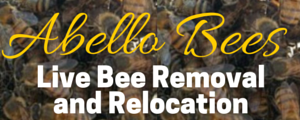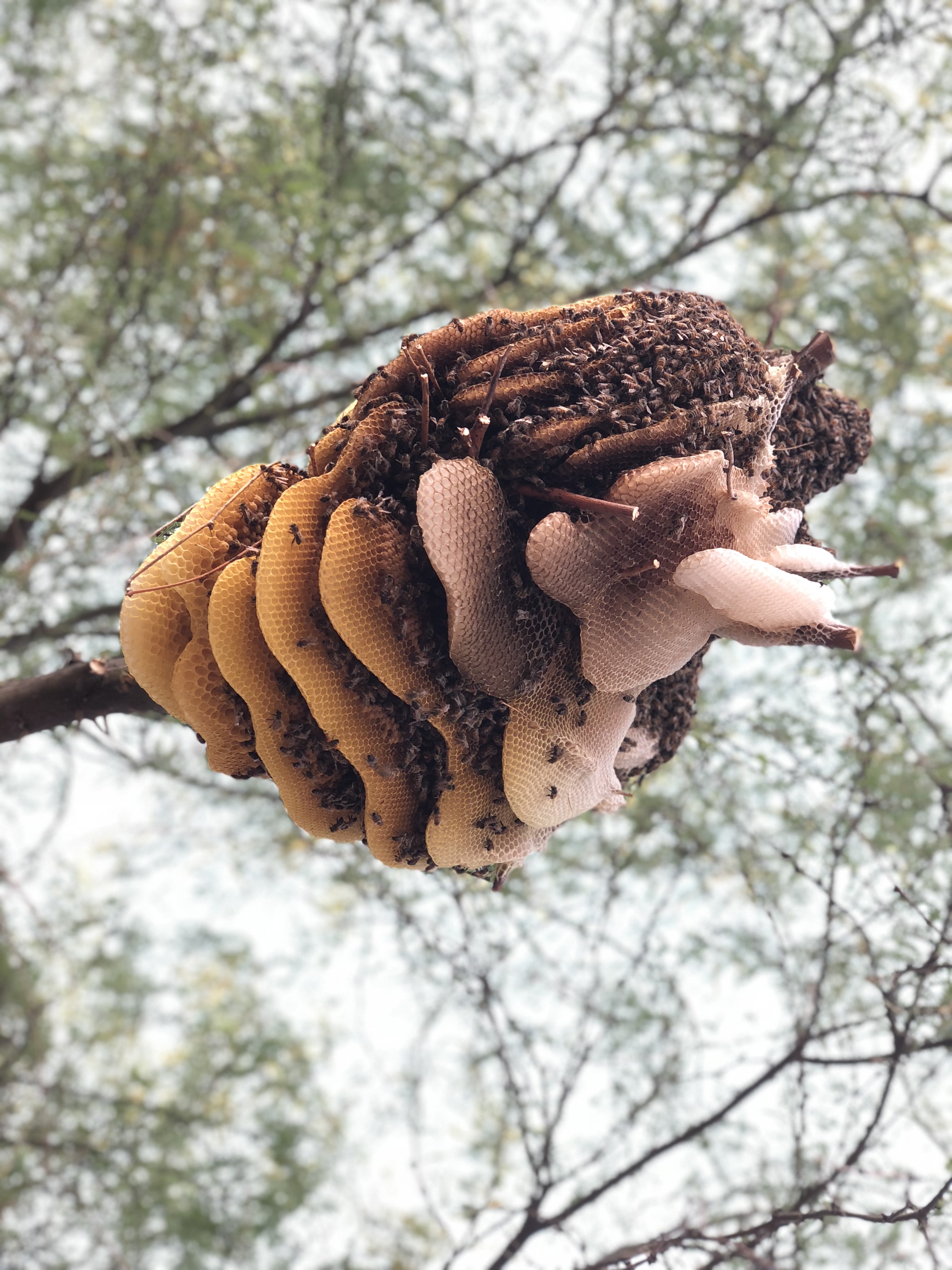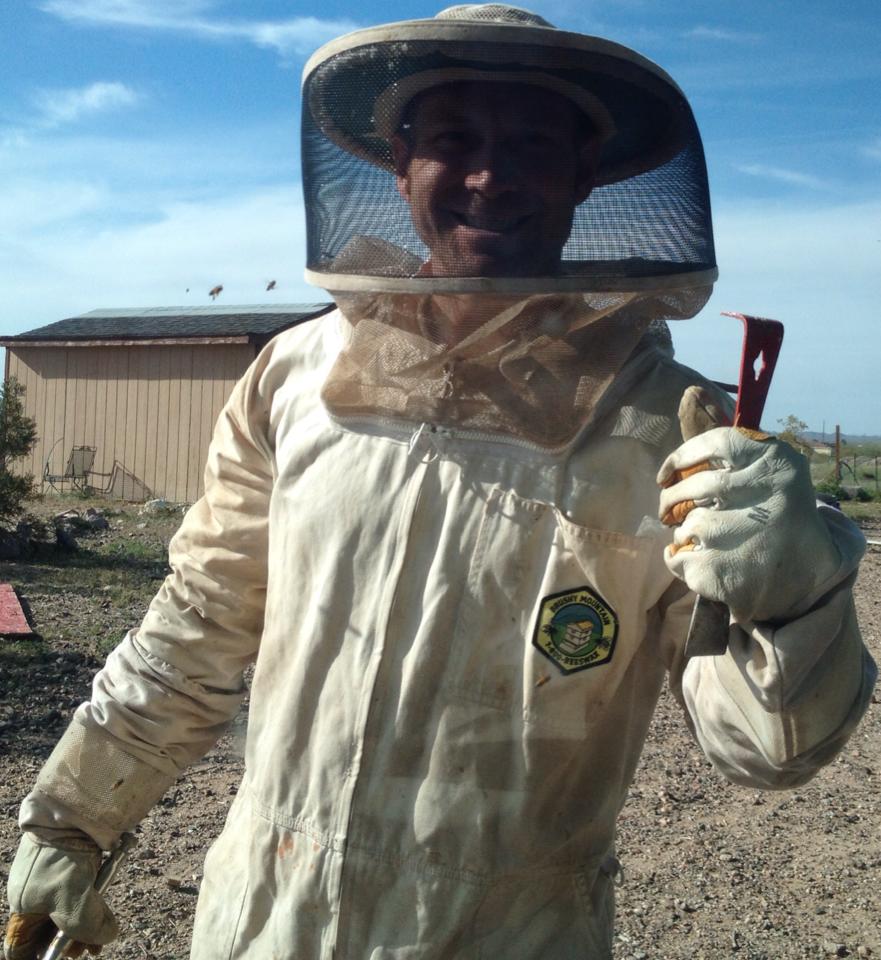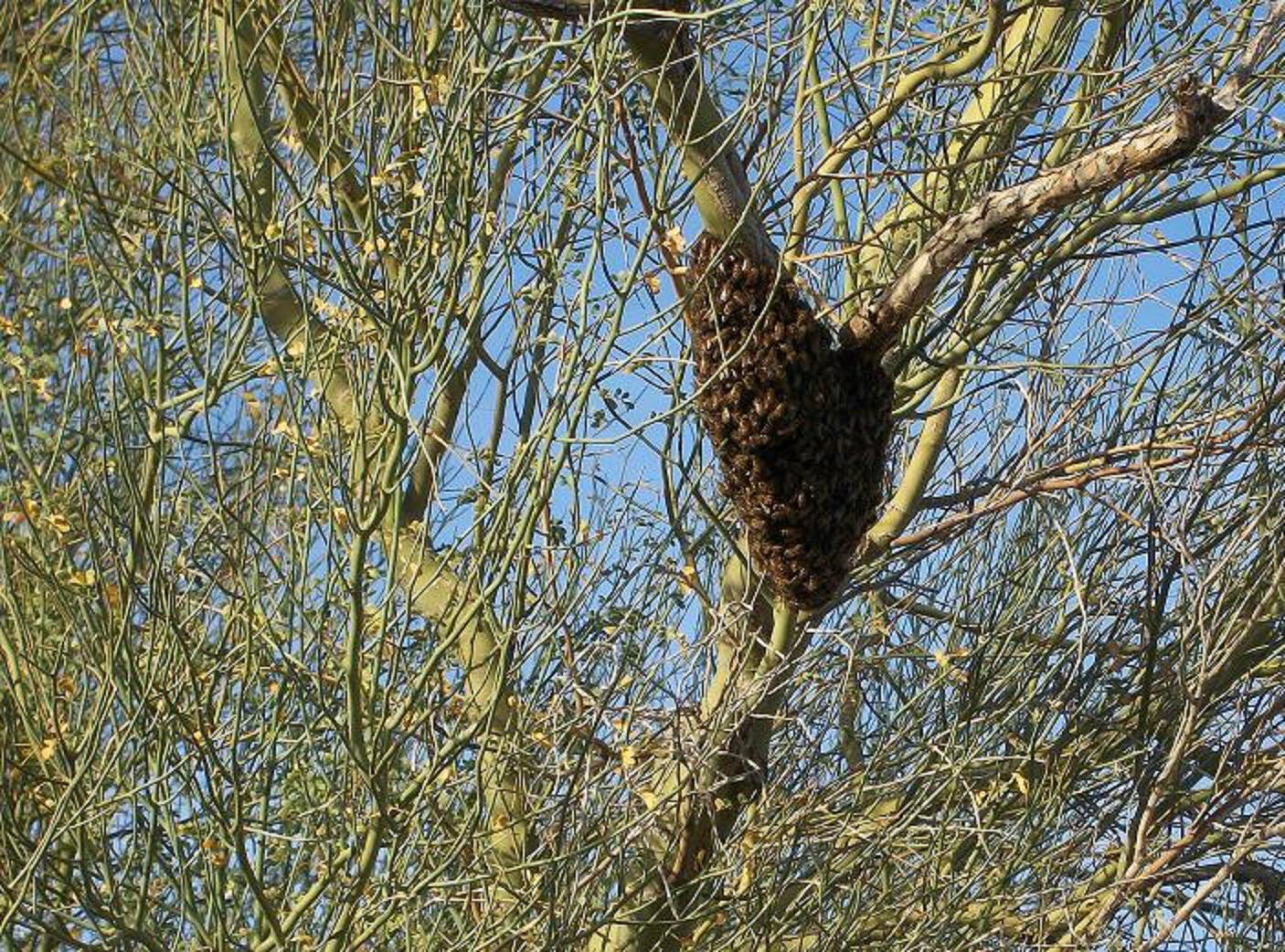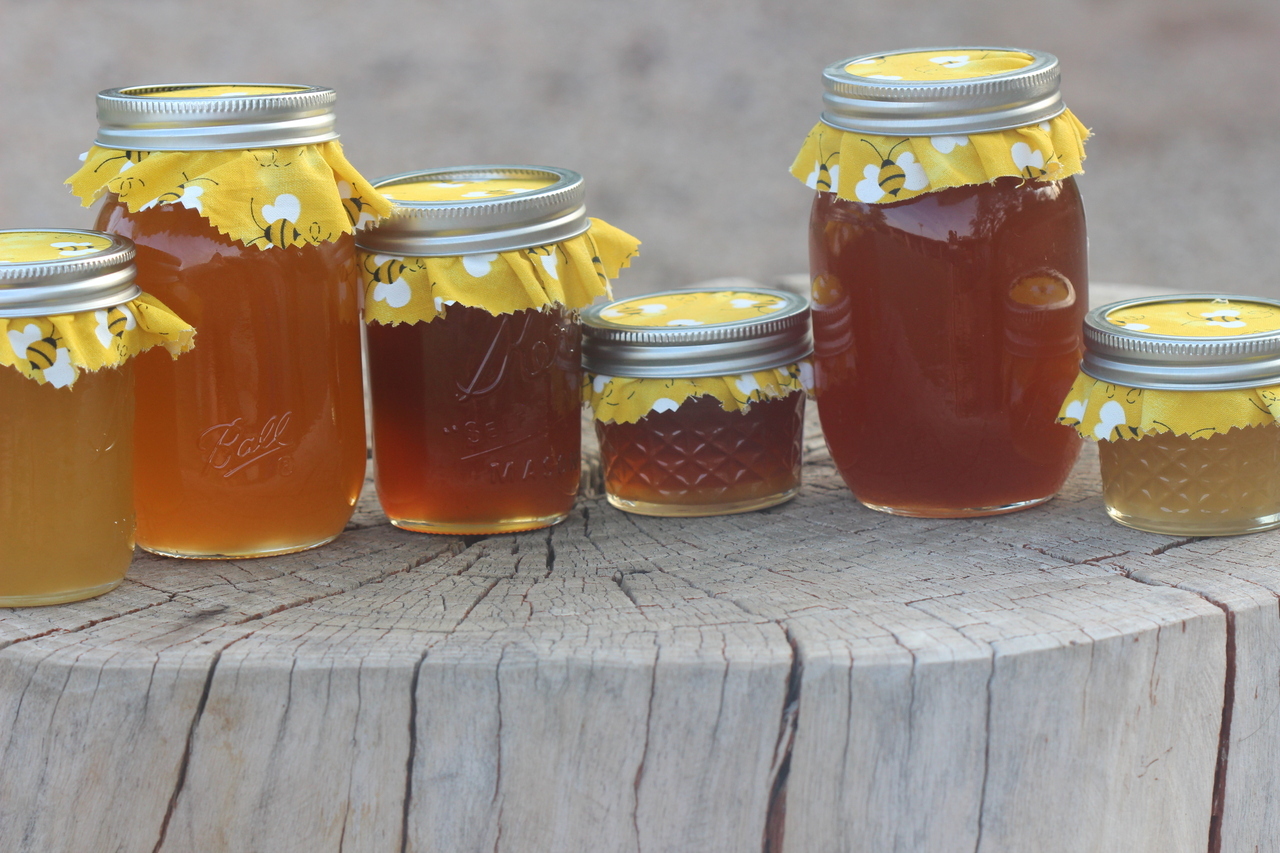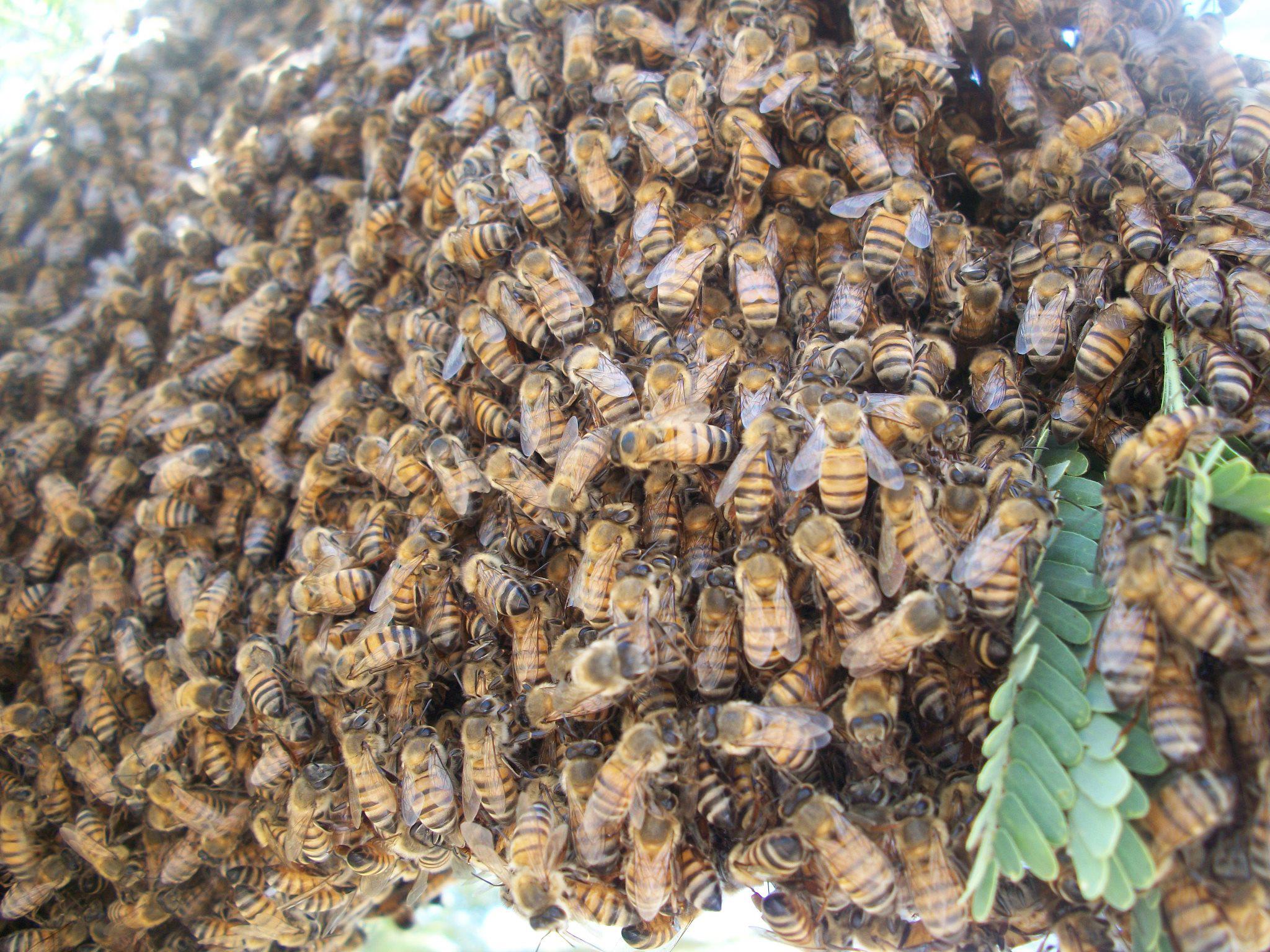Why is it Important to Save Bees Instead of Having Them Killed?
Frequently Asked Questions and Safety Concerns:
What do I do if I have Africanized Bees? Are they all Africanized?
There is no way to tell by looking at a bee if they are Africanized or not. The only way to know if through a lab test. Africanized bees are about 10% smaller. Some people say that all the bees in AZ are Africanized and I’m not sure that is true. I have seen every kind of bee there is. Black bees, yellow bees…highly aggressive bees that would chase me a mile and other hives so docile I could take off my suit around them.
The rule for bees is this, they only attack when they feel threatened. If you are handling them (or they think you are) or if you get too close to their hive that is a prime case for stinging. They are especially protective of their hive, the queen, their honey, and their brood (babies). If you see bees going in and out of a hole, either in a tree, or a house, or the dirt, assume that is a hive. Bee hives don’t always look like a stack of white boxes. The wild, feral bees will make their homes in anything that will provide shade and has space inside to build comb.
If you get too close you may get chased. The very aggressive bees may chase you quite far. Instead of 5-10 guard bees that chase you 10 feet, 500 bees can chase you 1 mile! So if you are being chased what should you do? Read on…..
What do I do if they chase me, my family or my pets?
Get inside! This seems like the worst thing to do because you don’t want them following you inside, but for some reason they don’t. In my experience, bees are timid of going inside and generally won’t enter the doorway. If they do it’s always by accident and they immediately look for windows (they see the light) to get out. They sense that something is not right and have no interest in the people who are in the house.
Where to go
So get inside a house, a shed, a car, all of these places discourage bees from continuing their attack on you. The ones who are the greatest concern are the young children. When they get scared they typically stop, paralyzed by fear. Make sure little children are supervised outside in areas unknown to you. Teach your children to run from bees, and run inside.
Dogs and cats
Dogs and cats usually have thick coats and even thin coats are better than soft human skin. Animals usually know how to run or get away, but there are times this isn’t the case. I was on a bee call and there was a feisty little Chihuahua that wanted to see us out in the yard removing a hive. It got too close and immediately started to be swarmed and stung by about one hundred bees. Instinctively, I scooped up the dog, and ran it to the front door smacking the bees off as I went. Within seconds the dog was inside. A few hours later the dog was fine, with no stings whatsoever (their hides can be quite protective), and the little guy had learned a new found respect for bees! Needless to say he stayed away after that!
Am I safe? I see bees drinking from my pool (or pollinating my tree, etc)
Bees are not out to kill people. They are busy, busy creatures. When they are getting a drink or pollinating they really have no interest in you. As I mentioned above, some bees are more aggressive in nature than others but the most important thing is to stay away from their hive. Personally, I always wear a suit when I go near the hives. So if you don’t have a hive at your house and just see them pollinating or getting a drink, just let them do their thing and you’ll be fine.
How do I get them to leave my property completely?
If you have a tree, when it is in bloom you are certainly going to see bees. If you have a garden of any kind, you will see them when you see flowers. If you have a pool or water feature, they may come around for a drink.
How to set up the pool
The pool can become the most problematic as the bees sometimes fall in and then grab onto a nearby swimmer for dear life, realize they are on a human, get scared, and sting out of instinct. You can drain the pool and they’ll go away, but if you refill it they’ll come back. The best scenario is drain the pool, then set up a kiddie pool (like one of those small ones for $10) at the back of your yard out of the way. Put a piece of floating wood in there to make it drown-safe for them and very inviting. Then that will train them to go there for water. After a week or so you can refill the pool. Having trained them to the new pool with the floating wood, they are more likely to leave the less inviting pool alone. But it’s never a sure bet. The best things is to find the hive if you can.
Bees typically don’t fly further than a 5 mile radius of their hive. So somewhere nearby there is a hive. You can try and find the source to get it removed.
Bees Or Wasp
Don’t know the difference? Go here to see what you may have.
What areas do you do bee removals in? All of Arizona
As a bee removal company in Arizona we serve:
| We accept all Credit Cards |
More Reasons to save bees, and what to expect. To stay current on our Youtube channel subscribe here: www.youtube.com/abellobees
Thank you so much for being the kind of young man that you are. People like you are hard to find these days. Best of luck in all that you do. God bless you and your family.
Honestly. I am so glad I went with live removal rather than extermination!
Clear, to the point, no nonsense explanation. Very educational, helpful… upfront business details, no surprises. Thank you!
Stop Bees Moving into Your Home or Business Once and for All
To some home owners/ business owners this is something that sounds nice. Maybe it’s a problem they’ve only had to deal with once or twice in a few years. But to some others, it’s a problem the’ve been dealing with for years and they are just simply tired of having to deal with bees moving into their property any longer. Once bees move in they leave pheromone all over the area where they moved in. This can be extremely hard to remove. Since bees can build about the volume of a basketball in 5 days, or in other words approximately 4,000 hexagon cells of honeycomb per day. Once bees have moved into your property, you will want the best possible solution to remediate the problem area where they moved in. This is best accomplished by a 3 fold method we discuss after our removals. Part of a premium remediation will include removing all residue and pheromone possible before repairs.
In order to stop bees from moving in again, the above is the beast approach just prior to then sealing your entire property or home properly. Most companies have no idea what to look for, as they are not accustomed to where bees will move in. In our thousands of live removals, and thousands more of cleaning up dead removals from companies that botched their bee removals, we have discovered the best possible remedy for keeping bees out.
Bees, Honey | Save them, don’t kill them
Honeybees are a wonderful and valuable superorganism. They provide us with honey and pollinate trees and plants that give us food and flowers. Please don't call an exterminator if you don't have to! In many cases beekeepers are able to successfully relocate your bees, and as a thank you we will gladly give you a some free honey and comb if your bees are producing on the spot (We harvest honey ONLY in spring once the pollen has started flowing, that way we know that what we are taking is truly excess from the bees winter stores, because remember, honey is the bees food). Therefore, if we collect your bees from a swarm, they will need to build comb to [...]
Best bee removal and relocation in Arizona
Call 480 334 2746 now for bee removal and relocation There is no alternative. We remove and relocate the bees with just our suit and tools. No pesticides, the only added aerosol is natural mesquite wood chips used in a smoker for the most aggressive bees and even that is rarely needed. Bees fall in a range from aggressive to docile. Even the most docile can become very nasty once their hive is messed with, and this is all a defense mechanism. We know how to remove and relocate bees naturally to our rustic apiary in the deep northwest where the bees are free of pesticide use and housed in a natural environment with only the hive box as their structure. Call [...]
Bee Removal FAQ
Do you remove bees humanely?
We remove bees alive 100% of the time. Anyone who doesn’t offer this is an exterminator. Abello Bees are only beekeepers who safely relocate bees to our managed hives.
How much does bee removal cost?
Bee removal cost depends on the size and location of the hive, but we always offer fair and affordable pricing. Call us at 480-334-2746 for a free quote.
Do you remove bees from walls, chimneys, or attics?
Yes. Our bee removal specialists can safely handle bee hives in walls, chimneys, roofs, and other hard-to-reach areas without using harmful chemicals.
Do you relocate honey bee swarms?
Yes, we specialize in live honey bee swarm removal and relocation. We safely capture the bees and move them to our apiaries where they can thrive.
Do you remove wasp or hornet nests?
Absolutely. We provide safe and effective wasp nest and hornet nest removal in addition to our humane bee removal services.
Can you help with carpenter bees?
Yes, our team provides carpenter bee exterminator and pest control services to protect your home from wood damage while safely handling the bees.
Do you offer emergency bee removal?
Yes. We offer emergency bee removal services across Arizona, including Scottsdale, Phoenix, Paradise Valley, Fountain Hills, Sun City, Surprise, Buckeye, Wickenburg, Glendale, Peoria, Arcadia, Gilbert, Chandler, Mesa, Anthem, and Wittmann. Call us anytime at 480-334-2746.
Contact Abello Bees Bee Removal
Address: 9375 E Shea Blvd #100, Scottsdale, AZ 85260
Phone: 480-334-2746
Hours: Sun–Fri: 5:00 AM – 8:00 PM | Sat: Closed

